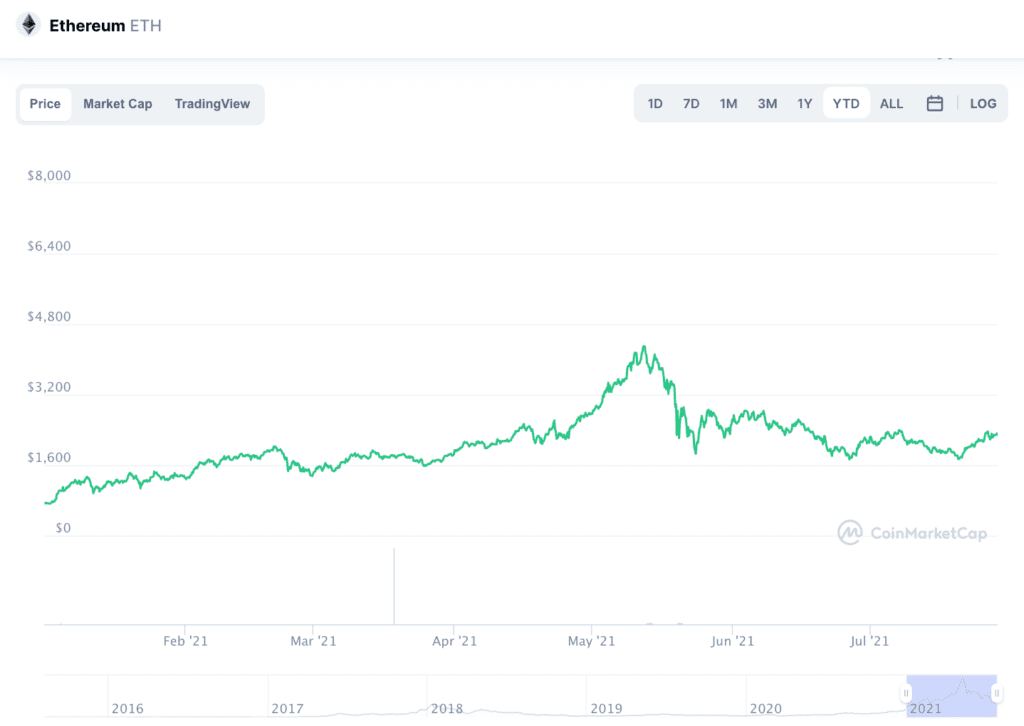The Ethereum network has grown substantially in 2021. The network is home to a burgeoning decentralized finance (DeFi) ecosystem, a healthy community of users, and a promising future as a popular development platform for smart contract-based applications. Will Ethereum as a store-of-value be ETH’s new role? Will Ethereum compete with traditional assets like gold and crypto-assets like bitcoin, with the recent steps toward the Eth2.0 network upgrade?
London Hard Fork Brings ETH Closer to Becoming a Store-of-Value
The upgrade to Eth2.0 will make Ethereum into a Proof-of-Stake (PoS) network. Traditionally, assets that belong to PoS networks are inflationary. Ethereum developers created new tokens and distributed them to stakers as rewards for their role in confirmation transactions. This is the case for Ethereum, the network will generate tokens to reward users for staking (ETH), its native token.
Ethereum developers have taken steps to prevent ETH from becoming an inflationary asset with Ethereum Improvement Proposal (EIP)-1559. The Proposal we call “Ethereum’s scarcity engine” or “ETH’s burn mechanism” destroys tokens that are paid as gas fees. This creates a deflationary force that will counteract inflationary pressure on ETH. The Protocol went live on August 5, 2021.
Because of this mechanism, some analysts say that ETH is on the road to becoming a “hard” asset, similar to BTC or gold. People describe both of these assets as “safe havens” against the rising tide of fiat inflation. Is EIP-1559’s deflationary mechanism enough to put ETH in the same category?
ETH: What is “Ultrasound” Money?
Ethereum developers and enthusiasts might believe that adding the burn mechanism to ETH’s tokenomics could change ETH from an asset that is primarily used to pay transaction fees into a defensive hedge against inflation.
The narrative of ETH as a store-of-value appears to have begun gaining traction in September of 2020 when Ethereum developer Justin Drake famously tweeted about “ultrasound” money: “If capped-supply BTC is sound money, [then] decreasing-supply ETH is ultrasound money,” he wrote.
if capped-supply BTC is sound money 📢
— Justin Ðrake 🦇🔊 (@drakefjustin) September 10, 2020
decreasing-supply ETH is ultrasound money 🦇 pic.twitter.com/Y9N8HBmHBr
EIP-1559’s deflationary mechanism isn’t the only reason that many see ETH as an “ultra-sound money”. Justin explained that Ethereum’s switch to PoS would make the network more secure than Proof-of-Work blockchains. Same as the bitcoin network, on an episode of the Bankless podcast.
According to Justin, this is because ETH tokens are the only thing necessary to operate the network securely. Ethereum does not need to rely on miners or any other externality. By contrast, the bitcoin network is entirely dependent on miners. This can lead to several problems: for example, if the value of mining equipment gets too low while the value of bitcoin remains relatively high, the network could become a target for attacks.
Is ETH a Store-of-Value like Bitcoin?
Drake also pointed to the fact that Ethereum draws its value from multiple different sources. Bitcoin primarily draws its value from its use as a store-of-value (and, to a degree, as a means of transaction.) However, Ethereum’s blockchain also has a thriving decentralized finance (DeFi) ecosystem that exists on top of it. It is the most popular platform for smart contract applications in the world.
This particular aspect of Ethereum’s value proposition began to attract institutional investors early in 2021 seriously.
In a note to clients published in January, Coinbase reported that its institutional clients were increasingly investing in Ethereum: “While our institutional clients predominantly bought Bitcoin in 2020, a growing number also took positions in Ethereum, the second-largest crypto asset by market capitalization,” the report said, adding that “The case for owning Ethereum…is a combination of its evolving potential as a store-of-value and its status as a digital commodity that is required to power transactions on its network.”
In other words, the growth of Ethereum’s DeFi ecosystem is a significant use case for ETH. Some analysts have even compared owning the asset to owning a tradable piece of the internet. The more applications that exist on the internet, the more that people use those applications. Subsequently, the applications generate more value. Similarly, the more applications that live on top of Ethereum, the more valuable ETH becomes.
Is ETH Really a “Safe-Haven Asset”?
Because of ETH’s role as a fundamental piece of the DeFi, some analysts consider ETH a low-risk compared to other cryptos. But “relative” is genuinely the keyword here–compared with many traditional markets, and all cryptocurrencies are risky assets. For example, ETH lost more than 50 percent of its value between its peak in May of 2021 and July of the same year. Similarly, Bitcoin lost more than half of its peak value between the months of May and July 2021.

Therefore, while many speak about ETH, BTC, and some other cryptocurrencies as defensive hedges against inflation, people do not consider them safe-haven assets. Never purchase more crypto than you can afford to lose. Click here to learn more about how to buy ETH, BTC, and other cryptocurrencies securely.
